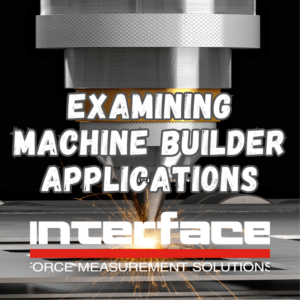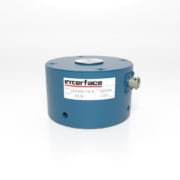Examining Machine Builder Applications
 Interface solutions test and measure the performance of all types of machines, from heavy-duty extraction equipment to tiny digits on robotic arms. Machine builders turn to Interface for the most precise and high-quality sensors for accurate data and device durability.
Interface solutions test and measure the performance of all types of machines, from heavy-duty extraction equipment to tiny digits on robotic arms. Machine builders turn to Interface for the most precise and high-quality sensors for accurate data and device durability.
Responsibilities of machine builders generally include defining machine requirements and use cases, creating technical specifications and drawings, selecting materials and components, building and testing machines, and installing and maintaining machines.
The specific responsibilities of a machine builder vary depending on the size and complexity of the machines they build and the use case of the machine. Depending on the industry and application, machine builders provide systems and machinery to meet specific production and operational requirements. These machines can be used for tooling, assembly, press operations, automated guides, and even cobots.
Machine Builder Applications Using Interface Products
- Industrial Automation Systems: This includes machines and systems used in manufacturing processes, such as robotic assembly lines, conveyor systems, and automated packaging machines. See: Snack Weighing and Packaging Machine App Note and Interface Manufacturing and Production Solutions
- Specialized Production Machinery: Machine builders design and build machinery for specific manufacturing processes, such as injection molding machines, CNC machines, or metal stamping presses. These machines form, stamp, and crush materials.
- Facilities Equipment: Machines like forklifts, cranes, and conveyor systems fall under this category. They are designed to move and handle materials efficiently within a facility. Read: Cranes and Lifting
- Universal Testing Machines (UTMs): These valuable machines test the mechanical properties of materials like metals, plastics, and composites.
- Weighing Systems: Used in various production processes like batching, mixing, and filling, weighing systems and scales are commonplace in most manufacturing facilities. Learn more: Load Cells for Smarter and More Efficient Weighing
As the machine building space becomes more precise with the evolution of automation and focus on efficiency across industrial facilities, force measurement becomes more critical to machine builders.
Interface products are used broadly for a variety of machines. Force measurement products, including our load cells, torque transducers, multi-axis sensors, and instrumentation, aid machine builders by measuring force, weight, tension, compression, and torque.
Machine builders use Interface sensor technologies in applications that weigh raw materials, test component designs, and build finished products to ensure they meet the required specifications. Force measurement devices are essential in measuring the machines or the processes force to control product quality and prevent accidents. Machine builders frequently use load cells to monitor loads over time to detect and prevent potential machine problems.
Automation is one of the most critical requirements driving the need for force measurement and precise Interface solutions. Automated processes require consistency and accuracy in every piece of the process to enable efficiency gains.
Benefits of Interface force measurement devices include:
- Improved safety
- Increased productivity
- Reduced waste and operating costs
- Quality improvement
- Reduced downtime
Machine Builder Application Notes
Robotic Sanding and Grinder Machine
Robotic grinding and polishing are commonly used in manufacturing for industrial applications. Machine builders design robots or cobots to grind and polish on different materials and surfaces. A force measurement system can monitor and control the force exerted on the grinding product. Interface’s Model 6A40A 6-Axis Load Cell can be installed between the flange and the grinding tool. When connected to the BX8-HD44 Data Acquisition, the customer can receive force and torque measurements when connected to their control system using BlueDAQ software. The customer connects the BX8’s analog outputs to their control system. This enables the customer to monitor, log, display, and graph these measurements. The results are sent to the customer’s control system via analog or digital output.
Press Machine Load Monitoring
Press forming is a method to deform different materials. For instance, materials such as steel can be bent, stretched, or formed into shapes. A force measurement solution is required to monitor the forces being applied by the press-forming machine. This ensures quality control and traceability during the production process. Interface recommends installing the 1000 High Capacity Fatigue-Rated LowProfile™ Load Cell for large press forming machines. When the material is placed under the punch plate to create a shape, the force applied is measured by the 1000. The captured force results are sent to the INF-USB3 Universal Serial Bus Single Channel PC Interface Module, where results can be graphed and logged on the customer’s PC using the provided software. Interface’s force measurement products and instrumentation accurately monitored and logged the force results of the press force machine, ensuring zero-error production performance.
Machine Use for Conveyor Belt
Conveyor belts for the food and beverage industry must be maintained and adequately aligned to transport products. A load cell is needed to prevent misalignment and to reduce the risk of damage or malfunction of the belt while in operation. Interface suggests installing PBLC Pillow Block Load Bearing Load Cells onto the conveyor belt. They are designed for easy maintenance. The PBLCs measure and monitor the force of the conveyor belt while preventing misalignment. The PBLC Pillow Block Load Cells successfully maintain the proper alignment of the conveyor belt for the food and beverages being transported while also monitoring the forces being implemented.
Machine builders turn to Interface for solutions that support Industry 4.0 innovations, enabling more efficiency and machine advancements. These professionals rely on Interface for the accuracy and quality of our solutions, the depth of our product offerings, and our experienced team that can help our customers select the right solution for their next application or develop custom applications to fit unique needs.
ADDITIONAL RESOURCES
Force Measurement Sensors are Essential to Modern Industrial Machinery
Interface Load Cells for Press Machines
Hydraulic Press Machines and Load Cells
Sanding Machine Force Monitoring
Interface Solutions for Machine Builders
Collaborative Robots Using Interface Sensors








